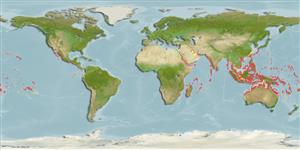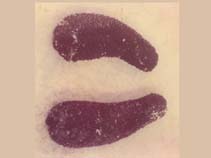Holothuria atra Jaeger, 1833
Lollyfish| Native range | All suitable habitat | Point map | Year 2050 |

|
| This map was computer-generated and has not yet been reviewed. |
| Holothuria atra AquaMaps Data sources: GBIF OBIS |
Classification / Names Common names | Synonyms | CoL | ITIS | WoRMS
Holothuroidea | Holothuriida | Holothuriidae
Environment: milieu / climate zone / depth range / distribution range Ecology
Benthic; depth range 0 - 30 m (Ref. 800). Tropical; 30°N - 32°S, 32°E - 78°W (Ref. 97480)
Distribution Countries | FAO areas | Ecosystems | Occurrences | Introductions
Indo-Pacific.
Length at first maturity / Size / Weight / Age
Maturity: Lm 15.5 range ? - ? cm Max length : 60.0 cm TL male/unsexed; (Ref. 118); common length : 20.0 cm TL male/unsexed; (Ref. 122); max. published weight: 1.0 kg (Ref. 122)
Short description Morphology
Body Width: 10 cm. Body Thickness: 0.8 cm. Mean live weight about 200 g to 1000 g; body thickness about 4 mm. Body: cylindrical, elongate, with rounded ends. Tegument smooth, often covered by sand, but also showing round patches lacking sand. A red toxic fluid is secreted upon rubbing the body surface vigorously. Podia on bivium sparsely distributed, ending in a small disc around 150 micrometer in diameter; podia on trivium numerous, short and stout, distributed on the radii and the interradii, their calcareous disc around 0.05 cm in diameter. Mouth: ventral, surrounded by 20 black tentacles. Anus terminal. Calcareous ring with large radial pieces and narrow interradials. Cuvierian tubules absent. Color: entirely black. Spicules: tegument with tables and rosettes; tables with circular disc showing 8 holes (4 central and 4 smaller holes in between) and s spire of 4 pillars, ending in maltese crown; rosettes small and simple, more abundant in ventral tegument; ventral podia without rods, but with pseudo-plates; dorsal podia and papillae with short rods, showing denticulate borders.
The mean population density is around 0.5 per square meter, but can exceed 4 per square meter. Traditionally harvested, but the processed product is of low commercial value. In recent times, due to increasing demand, this species also appears in the processed products of many Pacific Islands. Collected by hand at low tide while wading on the reefs, or by divers (Ref. 122). Processed to trepang in Puerto Princesa, Palawan (Ref. 543).
Life cycle and mating behavior Maturity | Reproduction | Spawning | Eggs | Fecundity | Larvae
Inshore shallow-water populations composed of smaller individuals, and reproduce mostly by transversal fission, while in deeper or outer reef populations the individuals are larger, and reproduce sexually (Ref. 122).
Main reference
References | Coordinator | Collaborators
Conand, C. 1998. (Ref. 122)
IUCN Red List Status (Ref. 130435: Version 2024-1)
Least Concern (LC) ; Date assessed: 18 May 2010
CITES status (Ref. 108899)
Not Evaluated
CMS (Ref. 116361)
Not Evaluated
Threat to humans
Human uses
Fisheries: minor commercial
| FishSource | Sea Around Us
Tools
More information
Trophic Ecology
Ecology
Population dynamics
Life cycle
Distribution
Human Related
Aquaculture profile
Stamps, Coins Misc.
Stamps, Coins Misc.
Outreach
References
Internet sources
BHL | BOLD Systems | CISTI | DiscoverLife | FAO(Publication : search) | Fishipedia | GenBank (genome, nucleotide) | GloBI | Gomexsi | Google Books | Google Scholar | Google | PubMed | Tree of Life | Wikipedia (Go, Search) | Zoological Record
Estimates based on models
Preferred temperature
(Ref. 115969): 24.9 - 29.3, mean 28.4 (based on 3685 cells).
Resilience
(Ref. 69278):
High, minimum population doubling time less than 15 months (K=0.11-0.75).
Price category
(Ref. 80766):
Unknown.
Nutrients : Calcium = 126 [75, 177] mg/100g; Iron = 4.79 [1.67, 7.92] mg/100g; Protein = 16.6 [15.4, 17.8] %; Omega3 = 0.331 [0.263, 0.400] g/100g; Selenium = 57.8 [48.5, 67.2] μg/100g; VitaminA = 0 μg/100g; Zinc = 1.97 [0.92, 3.02] mg/100g (wet weight); based on nutrient studies.



